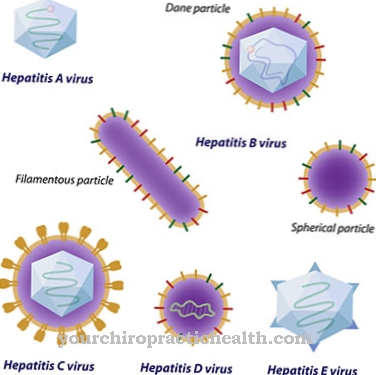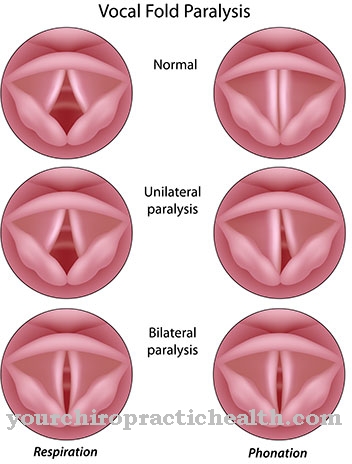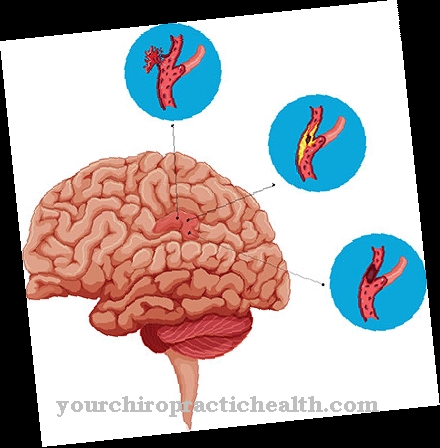A Erythrasma is a skin disease caused by a bacterial infection with pathogens of the type Corynebacterium minutissimum, which is relatively common with a prevalence of 5 to 10 percent. Men in particular are affected by erythrasma with a chronic course.
What is an erythrasma?

© 7activestudio - stock.adobe.com
As erythrasma (also Baerensprung's disease) is a superficial skin disease that can be traced back to a bacterial infection with Corynebacterium minutissimum.
Erythrasma manifests itself symptomatically in the form of smooth, sharply defined reddish discoloration of the skin that grows larger within several weeks, possibly confluent (unite) and develop fine lamellar flaking and yellowish-brown discoloration (coffee with milk).
In particular, the intertriginous skin areas (skin folds) such as armpits, groins as well as perianal and submammary (under the breast) areas are affected by erythrasma, as there is increased perspiration and impairment of the acid balance of the skin in these areas.
Symmetrical foci on the thigh in the area of the scrotum are also characteristic of erythrasma. As a rule, erythrasma occurs without itching and in many cases can have an asymptomatic course.
causes
Erythrasma manifests itself as a result of a bacterial infection with the gram-positive, saprophytic Corynebacterium minutissimum. In addition to dermatophytes and Candida albicans, the pathogen can also be found on healthy skin as a component of the normal skin environment.
If the environmental conditions are favorable for the pathogen as a result of disturbed skin flora due to increased perspiration (moisture) or heat development, it can multiply and attack the skin cells and the intercellular space of the stratum corneum (uppermost epidermal layer). The metabolic activity of the bacteria causes a dissolution of the keratin, the main component of the stratum corneum, which causes the characteristic skin changes.
In addition, hyperhidrosis (abnormal sweating), diabetes mellitus, obesity as well as immunosuppressive therapeutic measures (e.g. in the case of an HIV infection) and tight-fitting clothing are predisposing factors for erythrasma.
You can find your medication here
➔ Medicines against redness and eczemaSymptoms, ailments & signs
With erythrasma, those affected primarily suffer from various skin complaints. These have a very negative effect on the aesthetics of the person affected and significantly limit it. In many cases, this also leads to depression or inferiority complexes and reduced self-esteem. Those affected do not feel comfortable with their appearance.
The strong and extensive redness can lead to bullying or teasing, especially among children, so that they too suffer from psychological complaints. The skin itself flakes and changes its color. In the genital area, erythrasma can also be associated with pain or itching and thus have a very negative effect on the quality of life of the person concerned.
The disease often spreads to the neighboring regions and leads to redness and itching there too. As a rule, in addition to erythrasma, other skin complaints also occur at the same time, so that those affected can also suffer from dermatitis. However, life expectancy is not negatively affected by the disease. With a simple therapy, the symptoms can be relieved and limited relatively well.
Diagnosis & course
Erythrasma is diagnosed based on the characteristic skin changes. With the help of a so-called Wood lamp (UV or black light), pigment changes and the fluorescent foci on the skin, which fluoresce bright red or coral-colored in UV light due to the porphyrin formed by them, can be made visible.
The Gram-positive pathogens can also be detected microscopically by means of a Gram stain (blue color of the bacteria). Differential diagnosis requires differentiation from similar and equally common skin diseases such as cutaneous candidiasis, psoriasis, contact dermatitis, seborrheic dermatitis and tinea.
Trichomycosis palmellina and Keratolysis sulcata can also be caused by Corynebacteria. Erythrasma is a harmless infectious disease that, however, often has a chronic course in men and diseases such as hyperhidrosis or diabetes mellitus.
When should you go to the doctor?
If widespread reddening of the skin and other symptoms of erythrasma are noticed, a doctor should be consulted. If dandruff has already formed, it is best to seek medical advice immediately. The same applies to severe complaints such as itching or pain in the genital area and under the armpits. If these symptoms are noticed, there is definitely a serious skin disease. Only a dermatologist can determine whether it is an erythrasma.
People who suffer from hyperhidrosis, diabetes mellitus or obesity are particularly at risk. Increased perspiration or otherwise disturbed skin flora are risk factors that require quick clarification. If complications arise in the course of treatment, the responsible doctor must be informed.
In general, the therapy should be closely monitored in order to identify and treat any subsequent symptoms at an early stage. In addition to the general practitioner or dermatologist, you can also go to an internist with an erythrasma. A visit to the clinic is indicated if the symptoms are severe.
Doctors & therapists in your area
Treatment & Therapy
In the case of an erythrasma, the therapeutic measures include local therapy of the affected skin areas with ointments or creams containing imidazole, miconazole or fusidic acid or solutions with erythromycin. These substances dry the locally treated areas of the skin and at the same time have an antimicrobial effect.
A combination of acetylsalicylic acid (ASA) and benzoic acid can also be considered. For more severe or persistent courses, systemic therapy with erythromycin (250g four times daily) over a period of fourteen days may be indicated. Due to the high level of patient compliance (adherence to therapy), a single therapy with clarithromycin (1000mg) may also be considered.
Red light treatment can be used as part of photodynamic therapy measures, which represent an alternative to pharmacological approaches. An important part of the therapeutic measures in the case of erythrasma is also consistent body hygiene. For this purpose, the use of acid soaps or synthetic detergents (syndets or synthetically produced washing-active substances) to stabilize the skin flora is recommended, while moisture and greasy creams and ointments are avoided should.
The affected skin areas should generally be kept as dry as possible in the event of an erythrasma (e.g. by drying them thoroughly after bathing and showering). In people with obesity, more pronounced skin folds (especially under the breasts and in the groin) can be protected from moisture with the help of inserted gauze compresses, linen cloths and / or moisture-repellent powders.
In addition, air-permeable or breathable clothing should be worn to avoid increased perspiration in the case of erythrasma.
Outlook & forecast
The prognosis of erythrasma is favorable in most patients. The changes in the appearance of the skin are easily treatable with the medical options available. The administration of medicinal products usually results in significant improvements in the complexion of the skin within a few days. The abnormalities gradually recede until symptoms are free after about two weeks.
If complications arise, the prognosis worsens. With an unfavorable course of the disease, chronic erythrasma occurs. Men in particular belong to the risk group of this development. The person affected can independently take various measures to improve the prognosis. The skin should be kept dry and clothing should not be worn too close to the body.
The choice of clothing is crucial for alleviating the symptoms. In addition, obesity should be avoided, as irregularities in the skin's appearance often develop in the skin folds. As soon as the patient pays more attention to the care of the skin and perspiration on the body, the skin flora can be brought into balance. The improvement of the skin flora leads to a recovery.
Despite the favorable prognosis, a relapse can occur at any time in the course of life. The erythrasma can form again. The prognosis for a return is also favorable.
You can find your medication here
➔ Medicines against redness and eczemaprevention
As a prophylactic measure, an antimicrobial therapeutic agent can be applied locally once or twice a month for erythrasms with a tendency to recur. In addition, the predilection sites (preferably affected areas) should be kept dry and breathable clothing should be worn. Avoiding obesity through exercise can also prevent erythrasma.
Aftercare
As a rule, the early detection and rapid treatment of this disease is in the foreground in the case of erythrasma so that there are no further complications or other complaints. The earlier the erythrasma is detected, the better the further course of this complaint is usually. As a rule, this disease does not reduce the life expectancy of the person affected.
The treatment takes place with the help of medication. These should be taken exactly as directed by a doctor in order to alleviate the symptoms quickly and permanently. In cases of doubt or other uncertainties, a doctor should always be consulted. If the symptoms of the erythrasm do not go away after fourteen days, a doctor usually has to be consulted again.
Ointments or creams can also be used to alleviate the symptoms. Since the symptoms of the disease can also lead to psychological upset or depression, psychotic treatment is also useful. Intensive discussions with friends or family can also have a positive effect on the course of the disease. In order to prevent a new erythrasma, the underlying disease should also be analyzed.
You can do that yourself
Erythrasma is a harmless bacterial infection that can easily become chronic. Those affected should therefore consult a dermatologist as soon as possible. This is especially true for high-risk patients. This includes people who suffer from diabetes mellitus or who are very overweight and patients with a weak immune system.
Successful therapy always requires the help of the patient. A high level of personal hygiene is important. The infected areas must be cleaned regularly. It is best to use a slightly acidic cleaning agent to stabilize the skin environment. It is also important that the skin is kept dry.
After bathing or showering, the body must be completely dried with a fresh, clean towel. Profuse sweating is one of the causes of the development of the disease and should be avoided. If this is not possible, for example during sport, you have to shower promptly and then rub the body dry.
In people who are very overweight, the disease often affects the folds of the skin, as these are particularly warm and moist. To keep these areas dry, you can either insert gauze bandages or apply body powder several times a day. For some people, both measures may be indicated at the same time.
In addition, tight-fitting clothing should be avoided and loose-fitting, breathable textiles should be worn.
























.jpg)



